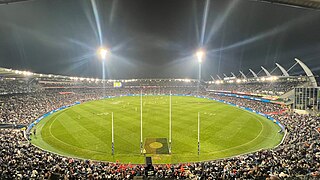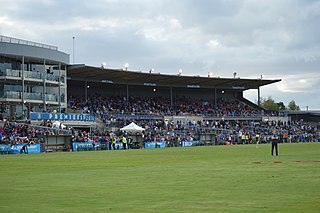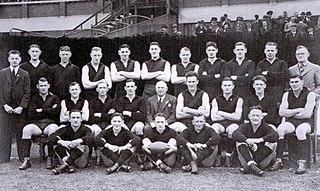
The Geelong Football Club, nicknamed the Cats, is a professional Australian rules football club based in Geelong, Victoria, Australia. The club competes in the Australian Football League (AFL), the sport's premier competition. The club formed in 1859, making it the second-oldest AFL side after Melbourne and one of the oldest football clubs in the world.

Kardinia Park is a sporting and entertainment venue located within Kardinia Park, South Geelong, in the Australian state of Victoria. The stadium, which is owned and operated by the Kardinia Park Stadium Trust, is the home ground of the Geelong Football Club, an Australian rules football club who compete in the Australian Football League (AFL). Kardinia Park can accommodate 40,000 spectators, making it the largest-capacity Australian stadium in a regional city, and the third largest-capacity stadium in Victoria behind the Melbourne Cricket Ground (100,024) and Docklands Stadium (56,347).

The 1907 VFL season was the eleventh season of the Victorian Football League (VFL), the highest-level senior Australian rules football competition in Victoria. The season featured eight clubs and ran from 27 April to 21 September, comprising a 17-match home-and-away season followed by a three-week finals series featuring the top four clubs.

Whitten Oval is a stadium in the inner-western suburbs of Melbourne, Victoria, Australia, located in Barkly Street, West Footscray. It is the training and administrative headquarters of the Western Bulldogs, which competes in the Australian Football League (AFL). The ground is also the home of the club's women's and reserves teams which compete in the AFL Women's (AFLW), Victorian Football League (VFL), and VFL Women's (VFLW).

Junction Oval is a historic sports ground in the suburb of St Kilda in Melbourne, Victoria, Australia.

Toorak Park is a cricket and Australian rules football arena in the Melbourne suburb of Armadale, Victoria, Australia. It is the home ground of the Prahran Football Club and Old Xaverians Football Club of the Victorian Amateur Football Association (VAFA) and Prahran Cricket Club, which plays in the Victorian Premier Cricket competition. The current capacity of the venue is 7,000.

In Victoria Australian rules football is the most popular sport overall, being the most watched and second most participated code of football. Australian rules football originated in Melbourne in the late 1850s and quickly came to dominate in the sport, which it continues to. Victoria has more than double the number of players of any other state in Australia accounting for approximately 42% of all Australian players in 2023 and continues to grow strongly. In 2023 there were 76 competitions and 1,242 clubs. According to Ausplay there are 227,213 adult of which about one in three are female and 96,068 children playing, similar numbers to soccer. The sport is governed by AFL Victoria based in Melbourne. The national governing body, the AFL Commission is also based in Melbourne.

The Yarraville Oval is an Australian rules football and cricket ground located on the corner of Williamstown Road and Anderson Street in Yarraville, Victoria. It is currently the home ground of the Yarraville/Seddon Eagles Football Club and the Yarraville Cricket Club.

The 1924 VFL season was the 28th season of the Victorian Football League (VFL), the highest-level senior Australian rules football competition in Victoria. The season featured nine clubs and ran from 26 April to 27 September, comprising a 16-match home-and-away season followed by a three-week finals series featuring the top four clubs.
The 1964 VFL season was the 68th season of the Victorian Football League (VFL), the highest level senior Australian rules football competition in Victoria. The season featured twelve clubs, ran from 18 April until 19 September, and comprised an 18-game home-and-away season followed by a finals series featuring the top four clubs.
The 1941 VFL season was the 45th season of the Victorian Football League (VFL), the highest level senior Australian rules football competition in Victoria. The season featured twelve clubs, ran from 26 April until 27 September, and comprised an 18-game home-and-away season followed by a finals series featuring the top four clubs.

The 1942 VFL season was the 46th season of the Victorian Football League (VFL), the highest level senior Australian rules football competition in Victoria.

The 1943 VFL season was the 47th season of the Victorian Football League (VFL), the highest level senior Australian rules football competition in Victoria.

The 1944 VFL season was the 48th season of the Victorian Football League (VFL), the highest level senior Australian rules football competition in Victoria.
Kardinia Park is a major public park located in South Geelong, Victoria. A number of public and sporting facilities are located in the park: a major AFL stadium, a secondary football oval, a cricket field, an open air swimming pool, a number of netball courts, various sporting clubrooms, and a senior citizens centre. The park is bounded by Moorabool Street, the Geelong railway line, Kilgour Street, Latrobe Terrace, and Park Crescent.
Australian rules football was first organised in Victoria in 1859 when its rules were codified by the Melbourne Football Club.
Con Gorozidis is a former Australian rules footballer who played for St Kilda and Footscray in the Victorian Football League (VFL).

The 1922 Victorian Football Association season was the 44th season of the Australian rules football competition. The premiership was won by the Port Melbourne Football Club, after it defeated Footscray by two points on 23 September, in a controversial Grand Final which several of its players were offered money to throw. It was the club's third VFA premiership.

Geelong (Association) Football Club was an Australian rules football club which played in the Victorian Football Association (VFA) from 1922 until 1927.

Geelong Greyhound Racing Club or The Beckley Centre is a greyhound racing venue located at Beckley Park, Broderick Road, Corio, Geelong, Victoria. The Beckley Centre is operated by the Geelong Greyhound Racing Club (GGRC) and regulated by Greyhound Racing Victoria (GRV). It hosts the Geelong Cup and has race distances over 400, 460, 520, 596 and 680 metres. Racing is conducted on Tuesday and Friday and occasional Saturdays.















